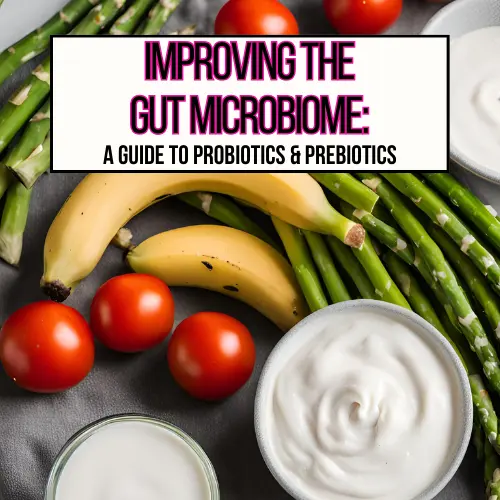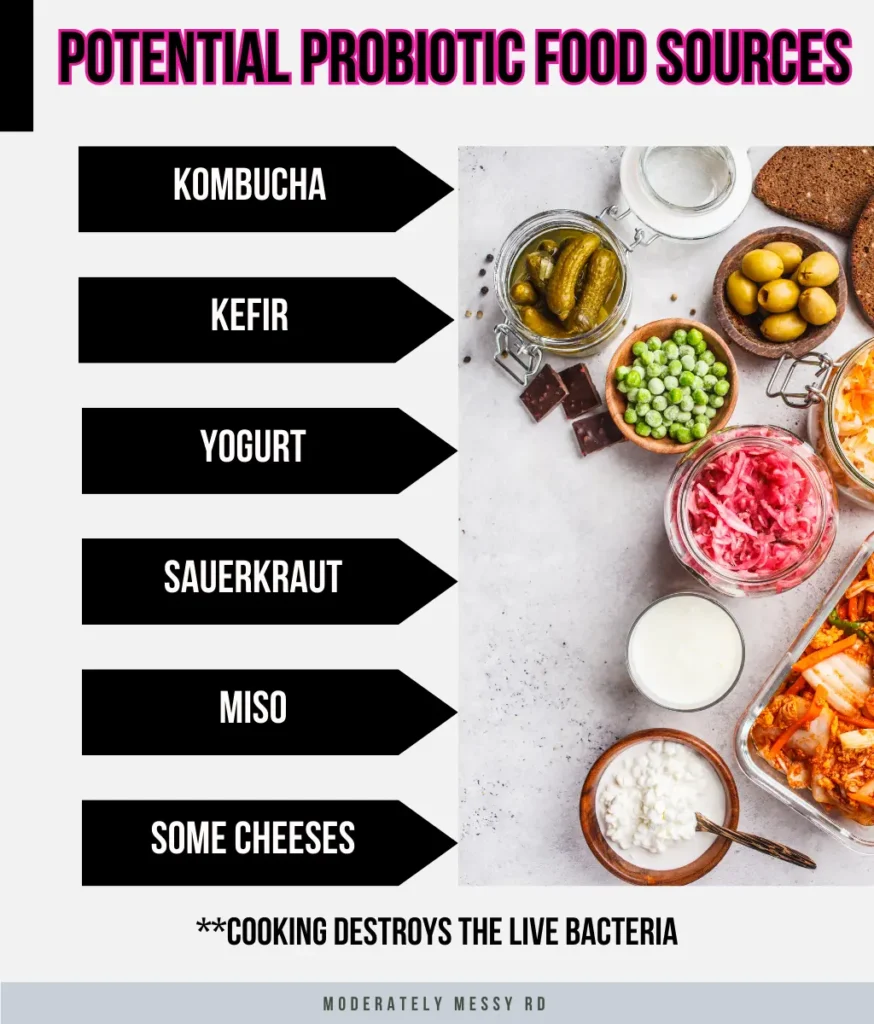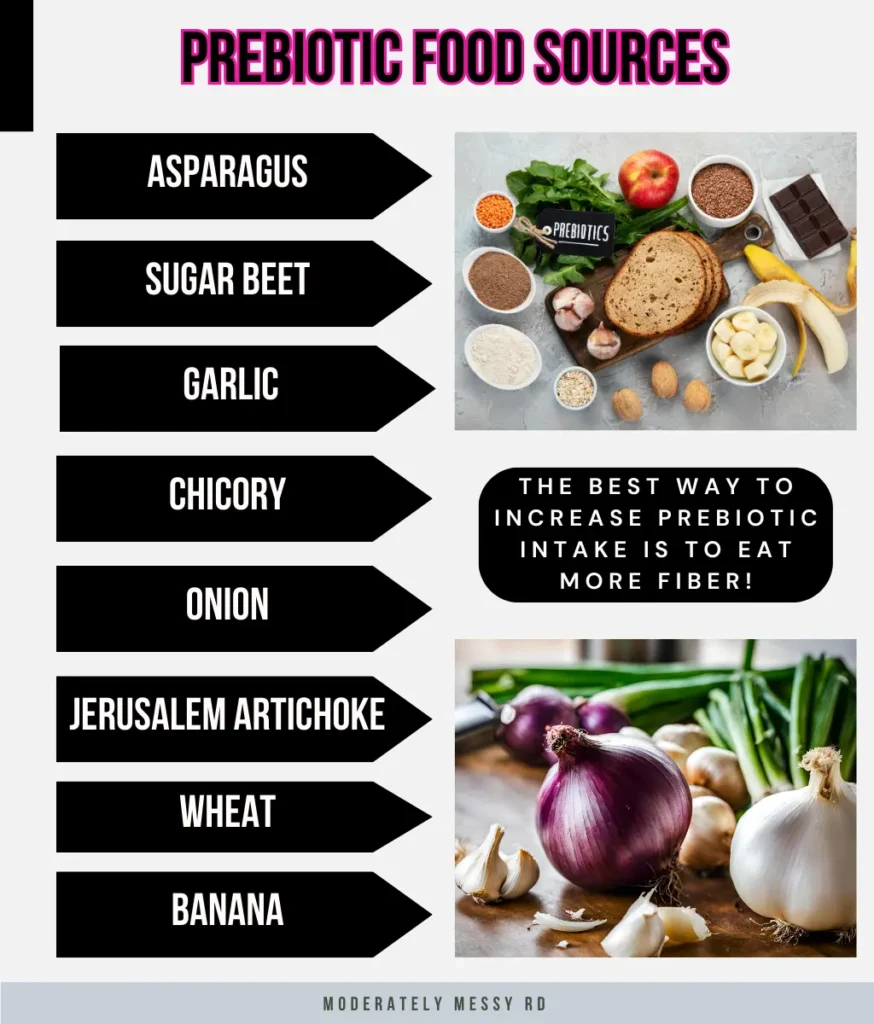Prebiotics and probiotics work together to create a more adaptive, resilient and diverse microbiome. This not only improves our gut, but has the potential for numerous health benefits throughout the body. In this ultimate guide to probiotics and prebiotics, I’ll attempt to answer all your burning questions: like what foods to consume, if you should take a supplement, and tips to create a more balanced gut microbiome.

The subject of improving the gut microbiome is very complex but continues to be a topic of increasing interest. There is exciting new research regarding probiotics and prebiotics, and the benefits they have on our health continues to be conducted to further understand the relationship. Let’s discuss!
What Are Probiotics?
Probiotics are defined as live microorganisms that, when administered in adequate amounts, confer a health benefit to the host. To be considered a probiotic, the live microorganism must be a characterized strain with health benefits that have been scientifically proven.
Probiotics can be classified by genus, species and strain. Each strain of the same species may offer different benefits.
For probiotics to provide health benefits, we must consider:
Health Benefits of Probiotics
Probiotics help to support a healthy gut microbiome – but that’s not all! Recent research suggests there is potential to enhance immunity, improve metabolic health and positively impact a number of health conditions like type 2 diabetes, osteoporosis, IBS, autism, and chronic kidney disease. There is even evidence probiotics may improve mood and cognitive function.
Therefore, it will be exciting where this field of research goes and what else they uncover.
What Foods Contain Probiotics?
I wish there were a “probiotic foods list” but the answer isn’t so black and white. Fermented foods are thought to be the best food sources of probiotics as the fermentation process produces lactic acid bacteria and yeasts. Examples include kombucha, kefir, yogurt, sauerkraut, and kimchi.

While these foods do contain live, active cultures, not all of them are considered to have probiotics. According to the National Institute of Health, determining if a food is considered a “probiotic” depends on a lot of factors – like the microorganism levels they contain when eaten, whether they survive the intestinal transit, the specific species and if it has potential health benefits.
The good news is that the research is promising regarding the many products available these days. A recent review of studies implied that the bacteria in fermented foods are capable of surviving gastric transit – and this may be a common property in commercially available products.
Kombucha, a fermented tea beverage, will sometimes have “probiotics” on the label. However, a recent study found that commercial kombucha products may differ from each other in regards to the amount of bacteria and their benefits.
So, in conclusion: fermented foods do have live, active cultures but to be classified as a probiotic there must be specific factors which are not highly regulated. It’s hard to say if all the products available can be classified as such – but either way, most research suggests consuming these foods can have a positive impact on our health long-term.
Tips for Selecting Probiotic Foods
The best practice is to look for products which not only state there are probiotics in it, but list the specific strains as well! Most commercial yogurt will have probiotics – but Activia yogurt specifically lists the strain B. (animalis) lactis CNCM I-2494. The Chobani yogurt that I use lists 6 live, active cultures on the label.
If you don’t see the specific strains listed on the label, sometimes a quick search on the product’s website can reveal that information. Kefir is one of THE BEST sources, in my opinion, often containing significantly more strains than even yogurt. I use Lifeway Kefir for smoothies, overnight oats, and honestly – it tastes similar to a drinkable yogurt.

Try These Recipes Using Kefir and Kombucha:
— Lemon Berry Overnight Oats with Kefir
— Refreshing Kombucha Mocktails
— Strawberry Kefir Smoothie
Should You Take a Probiotic Supplement?
It’s only beneficial to take a probiotic supplement if there is research that has identified a strain and dose specific benefit. My best advice to you is to check out the US Probiotic Guide which lists probiotic supplements on the market, the strain identified, the dose at which to take it, and the proposed health benefit!
For example, Calm Biotic contains probiotics B. longum R0175 and L. helveticus R0052 with evidence to reduce symptoms of stress and anxiety. Clinical studies have identified multiple strains of probiotics effective for antibiotic associated diarrhea – found in the probiotic chart on the website.
If you’re just looking to improve overall health and increase the diversity of your gut microbiome, I recommend making sure that the supplement is third-party tested to ensure it actually contains the ingredients listed.
It’s also important to understand that probiotics must survive the harsh acidic environment of the stomach – which can kill the bacteria before reaching the colon. Probiotic supplements, like DS-01 Daily Synbiotic, have specifically formulated capsules to survive intestinal transit.
Potential Side Effects of Probiotics
While generally recognized as safe, those with weakened immune systems or gastrointestinal disorders should be careful when consuming probiotics. There have been some cases of bacteremia, sepsis and endocarditis.
Prebiotics
The current definition of prebiotics is “a substrate that is selectively utilized by host microorganisms conferring a health benefit”. Most often, they are described as the food for probiotics. Prebiotics feed the intestinal microbiota, and release short-chain fatty acids into the blood upon degradation.
These short-chain fatty acids affect not only the GI tract, but also other organs – so consumption can provide numerous potential health benefits throughout the entire body.
Foods That Contain Prebiotics
The most commonly-studied prebiotics are the soluble fibers inulin, fructooligosaccharides (FOS), galactooligosaccharides (GOS), and human milk oligosaccharides (HMOs). Some of the best sources of prebiotics are in foods like sugar beet, asparagus, garlic, chicory, onion, Jerusalem artichoke, tomato, wheat, honey, banana, barley, cow’s milk, peas, beans, and seaweed.

However, not all prebiotics are carbohydrates. Cocoa powder is considered a prebiotic because it contains polyphenols.
According to the International Scientific Association of Probiotics and Prebiotics, there are no official dietary recommendations for prebiotics in healthy individuals. They suggest an oral dose of at least 3 grams per day to product a health benefit with a target of 5 grams of FOS and GOS in the daily diet.
What does this mean? Most experts agree that you can reach this target if you consume the recommended intake of fiber daily. I have a lot of resources on my site to help you reach this goal, and a 14-Day High Protein and Fiber Meal Plan.
Health Benefits of Prebiotics
So, we know that prebiotics produce substrates which affect our entire body. Because they provide food for the good bacteria in our gut, many of the benefits coincide with probiotic consumption as well. Some of the proposed benefits of prebiotics are listed below.
Prebiotic Supplements
It’s always best to try and consume prebiotics from foods before trying a supplement. That being said, there are a lot of options available – like Benefiber and Prebiotic Inulin Fiber. Fiber supplements can have unwarranted side effects, so be sure to start low and go slow.
There are even prebiotic sodas available these days, like Olipop and Poppi. Olipop, specifically, has 9 grams of prebiotic fiber per can from ingredients such as chicory root, Jerusalem artichokes, and Nopal cactus. Are these sodas highly regulated? Not really – but they are a tasty (and expensive) way to increase prebiotic fiber if you are not consuming much fiber in your diet.
Potential Side Effects
Most prebiotics are high in FODMAPs and may cause flatulence, nausea and bloating for those who follow a low FODMAP diet. Monash University has a prebiotic fiber guide that is suitable for a low FODMAP diet!
It’s All About Finding a Balance
It’s so interesting that our gut is so closely related to overall human health and well-being. Both probiotics and prebiotics are extremely important in a healthier, more balanced gut microbiome. Consuming more fermented foods and foods high in fiber can help to increase the diversity and composition – resulting in numerous benefits to our health!
For more ideas on how to improve your gut microbiome, check out my post on Food Swaps for Gut Health with Recipes!
